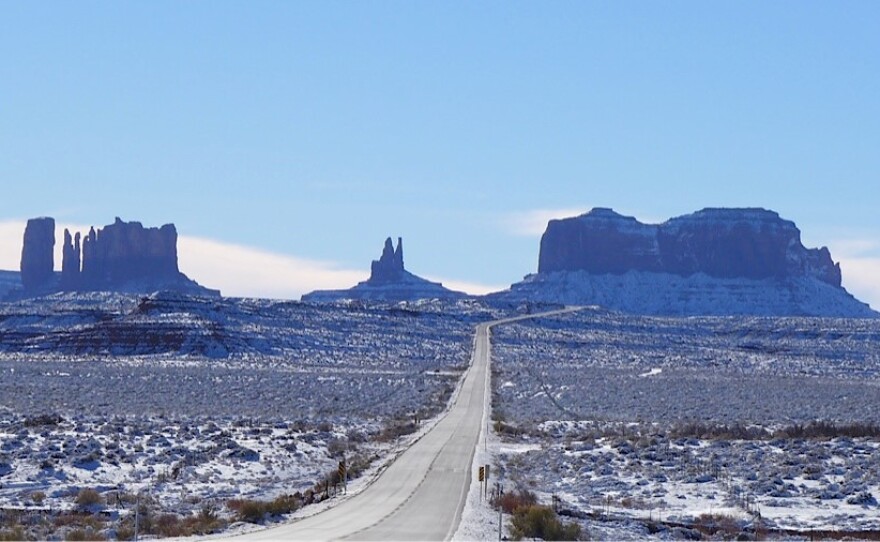We were a stones throw from the Arizona border. Hundreds of mostly Navajos and Utes, from Utah and the Four Corners, traveled long miles in sudden winter conditions, to gather at the well-heated Monument Valley Welcome Center. Residents of remote desert chapters mingled with the highest ranks of elected leadership from the Navajo Nation and the Utah Dine Bikeyah, and a smattering of sympathetic activists from regional environmental groups.
Marc Thomas from Moab represented the Utah Sierra Club.
“The Utah Chapter of the Sierra Club has enthusiastically backed the efforts of the Bears Ears Intertribal Council. You know, in 2008 I went to Washington DC for President Obama’s inauguration. I really thought that was a historic moment, and I’ve got the same sort of feeling today.”
Tribal gatherings include music, speeches, prayer and food, and more often than not, a full-contingent color guard of local military vets.
The group was welcomed by James Adakai, president of the Oljato chapter and a long active member of the 5-tribe coalition.
“The Hopi, the Zuni, Ute Mountain Ute, the Uinta and the Navajo Nation. I thank you for your vision, for your leadership, and perseverance. No one can change our tribal history, our tribal cultural significance, tied to a Bears Ears history. And today this designation of Bears Ears National Monument, no one will change that as well.”
From Window Rock, most of the top brass from the Navajo Nation were in attendance, including Vice President Jonathan Naz.
“Congratulations to each and every one of you. (Speaks a few words in Navajo). And it is a collaborative effort for each and every one of you to be here in celebration. So all the stars lined up together to make this all happen. We got the monument designated, but it’s only the start of a larger battle. And so we need to gather ourselves together again in a coalition to continue the fight to save our lands for the future of all people in this great United States of America.”
From Towaoc, Ute Mountain Ute Council member Regina Lopez-Whiteskunk has been active as co-chair of the tribal coalition. President Obama followed her tweets.
“This is a victory for each and every one of us, not just Native people, but I’m talking about the rock climbers, the backpackers, the settlers. Find the real Donald Trump on Twitter. Let him know how you feel, ‘cause I hear that’s where he does a lot of his business. Yes we got a designation, but now we still face more threats. Beyond tribal lines, beyond color, beyond whatever it is, the difference has seemed to always be the water that cracks the stone. Let’s not be that water. It is our victory. We have changed history. We are not just a check mark on a box any more. Now it’s our time to step up and prove that.”
This unassuming looking cowboy is Leonard Lee from Aneth. Leonard is an herbal medicine man whose day job is working for an oil company. He’s the vice chair of Dine Bikeyah, and a key activist in the push for Bears Ears.
“I’m a very traditional individual, to where that I’m, the family that I grew up with were traditional people. My grandpa, my mom were herbalists, which was passed on down to me. There’s a lot of medicine that grows in that area, Bears Ears. And also the protection of the land itself. Not for us, it’s for the younger generation, our children and also their grandchildren and their grandchildren.”
Tribal medicine men offer up prayers and chanting, and nobody can yet divine what the Trump world will visit on the reservation. Ryan Zinke, proposed new Interior Secretary, says his top priority is to visit Utah. Zinke has said Trump “perhaps” has the power to reverse the Bears Ears designation.







